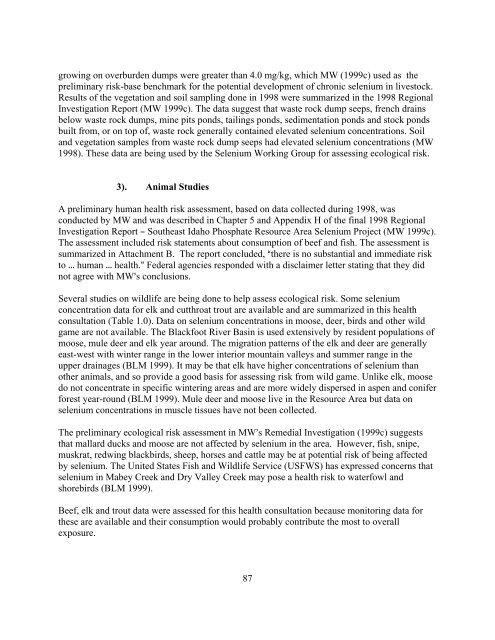Southeast Idaho Phosphate Mining Resource Area - Agency for ...
Southeast Idaho Phosphate Mining Resource Area - Agency for ...
Southeast Idaho Phosphate Mining Resource Area - Agency for ...
Create successful ePaper yourself
Turn your PDF publications into a flip-book with our unique Google optimized e-Paper software.
growing on overburden dumps were greater than 4.0 mg/kg, which MW (1999c) used as the<br />
preliminary risk-base benchmark <strong>for</strong> the potential development of chronic selenium in livestock.<br />
Results of the vegetation and soil sampling done in 1998 were summarized in the 1998 Regional<br />
Investigation Report (MW 1999c). The data suggest that waste rock dump seeps, french drains<br />
below waste rock dumps, mine pits ponds, tailings ponds, sedimentation ponds and stock ponds<br />
built from, or on top of, waste rock generally contained elevated selenium concentrations. Soil<br />
and vegetation samples from waste rock dump seeps had elevated selenium concentrations (MW<br />
1998). These data are being used by the Selenium Working Group <strong>for</strong> assessing ecological risk.<br />
3). Animal Studies<br />
A preliminary human health risk assessment, based on data collected during 1998, was<br />
conducted by MW and was described in Chapter 5 and Appendix H of the final 1998 Regional<br />
Investigation Report B <strong>Southeast</strong> <strong>Idaho</strong> <strong>Phosphate</strong> <strong>Resource</strong> <strong>Area</strong> Selenium Project (MW 1999c).<br />
The assessment included risk statements about consumption of beef and fish. The assessment is<br />
summarized in Attachment B. The report concluded, Athere is no substantial and immediate risk<br />
to Y human Y health.@ Federal agencies responded with a disclaimer letter stating that they did<br />
not agree with MW=s conclusions.<br />
Several studies on wildlife are being done to help assess ecological risk. Some selenium<br />
concentration data <strong>for</strong> elk and cutthroat trout are available and are summarized in this health<br />
consultation (Table 1.0). Data on selenium concentrations in moose, deer, birds and other wild<br />
game are not available. The Blackfoot River Basin is used extensively by resident populations of<br />
moose, mule deer and elk year around. The migration patterns of the elk and deer are generally<br />
east-west with winter range in the lower interior mountain valleys and summer range in the<br />
upper drainages (BLM 1999). It may be that elk have higher concentrations of selenium than<br />
other animals, and so provide a good basis <strong>for</strong> assessing risk from wild game. Unlike elk, moose<br />
do not concentrate in specific wintering areas and are more widely dispersed in aspen and conifer<br />
<strong>for</strong>est year-round (BLM 1999). Mule deer and moose live in the <strong>Resource</strong> <strong>Area</strong> but data on<br />
selenium concentrations in muscle tissues have not been collected.<br />
The preliminary ecological risk assessment in MW=s Remedial Investigation (1999c) suggests<br />
that mallard ducks and moose are not affected by selenium in the area. However, fish, snipe,<br />
muskrat, redwing blackbirds, sheep, horses and cattle may be at potential risk of being affected<br />
by selenium. The United States Fish and Wildlife Service (USFWS) has expressed concerns that<br />
selenium in Mabey Creek and Dry Valley Creek may pose a health risk to waterfowl and<br />
shorebirds (BLM 1999).<br />
Beef, elk and trout data were assessed <strong>for</strong> this health consultation because monitoring data <strong>for</strong><br />
these are available and their consumption would probably contribute the most to overall<br />
exposure.<br />
87
















